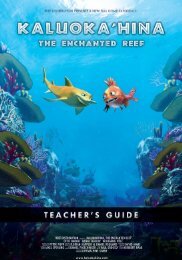EARTH, MOON & SUN - Peoria Riverfront Museum
EARTH, MOON & SUN - Peoria Riverfront Museum
EARTH, MOON & SUN - Peoria Riverfront Museum
Create successful ePaper yourself
Turn your PDF publications into a flip-book with our unique Google optimized e-Paper software.
<strong>EARTH</strong>, <strong>MOON</strong> & <strong>SUN</strong>KEY SCIENTIFIC VOCABULARYYour students will be exposed to these sci- Earth, Moon &Sun. Afterward, you may wish to exploreseveral further in your classroom by incorporatingthem into discussions of the show andinto follow-up lesson plans, including a writingassignment.atmosphere. The gases that surround a planet,moon, or star.climate. The average weather in different regionsof the Earth.energy. The capacity for doing work.erosion. The result of being worn away becauseof water, wind, or glacial ice.gravity. A physical force that pulls objects together.hemisphere. Half of a sphere. The Earth isdivided into northern, southern, eastern, andwestern hemispheres.horizon. An imaginary circle that marks theboundaries of the sky and the Earth, or an extensionof the plane of the observer.maria. Dark plains on the Moon caused bynuclear fusion. An atomic reaction in whichmany nuclei combine together to make a largerone. The result of this process is the release ofa large amount of energy. The Sun is poweredby nuclear fusion, like all stars, converting hydrogeninto helium.orbit. A path that an object takes as it revolvesaround another object.photosynthesis. This process, which involvesthe Sun, turns carbon dioxide to oxygen.rotation. To turn once around an axis.seasons. Spring, summer, fall, and winter. Theseasons are caused by the tilt of the Earth’s axis.solar eclipse. This is what happens when theMoon blocks our view of the Sun.sundial.object called a “GNoman” to project a shadow,enabling it to use the Sun’s light to tell time.sunspots. Dark patches on the Sun’s surfacethat are thousands of degrees cooler than therest of the luminous surface.telescope. An instrument that makes distantobjects such as the stars appear closer, lettinghumans see things in space.Adapted from www.learnnc.organd www.dictionary.comPLANETS, Morehead Planetarium and Science Center, University of North Carolina at Chapel Hill, NC 27599© 2010, 2011 by Morehead Planetarium and Science Center 25





